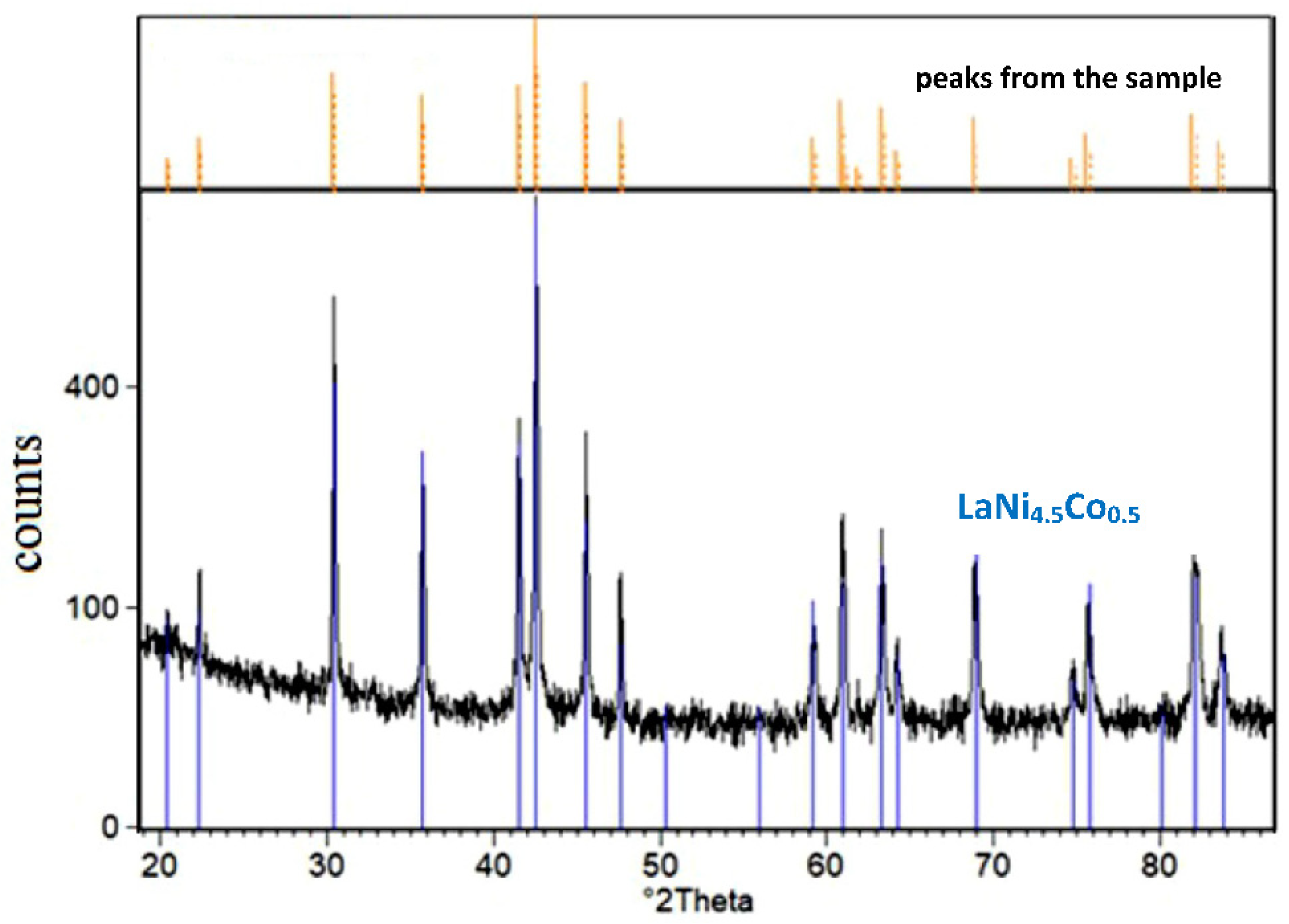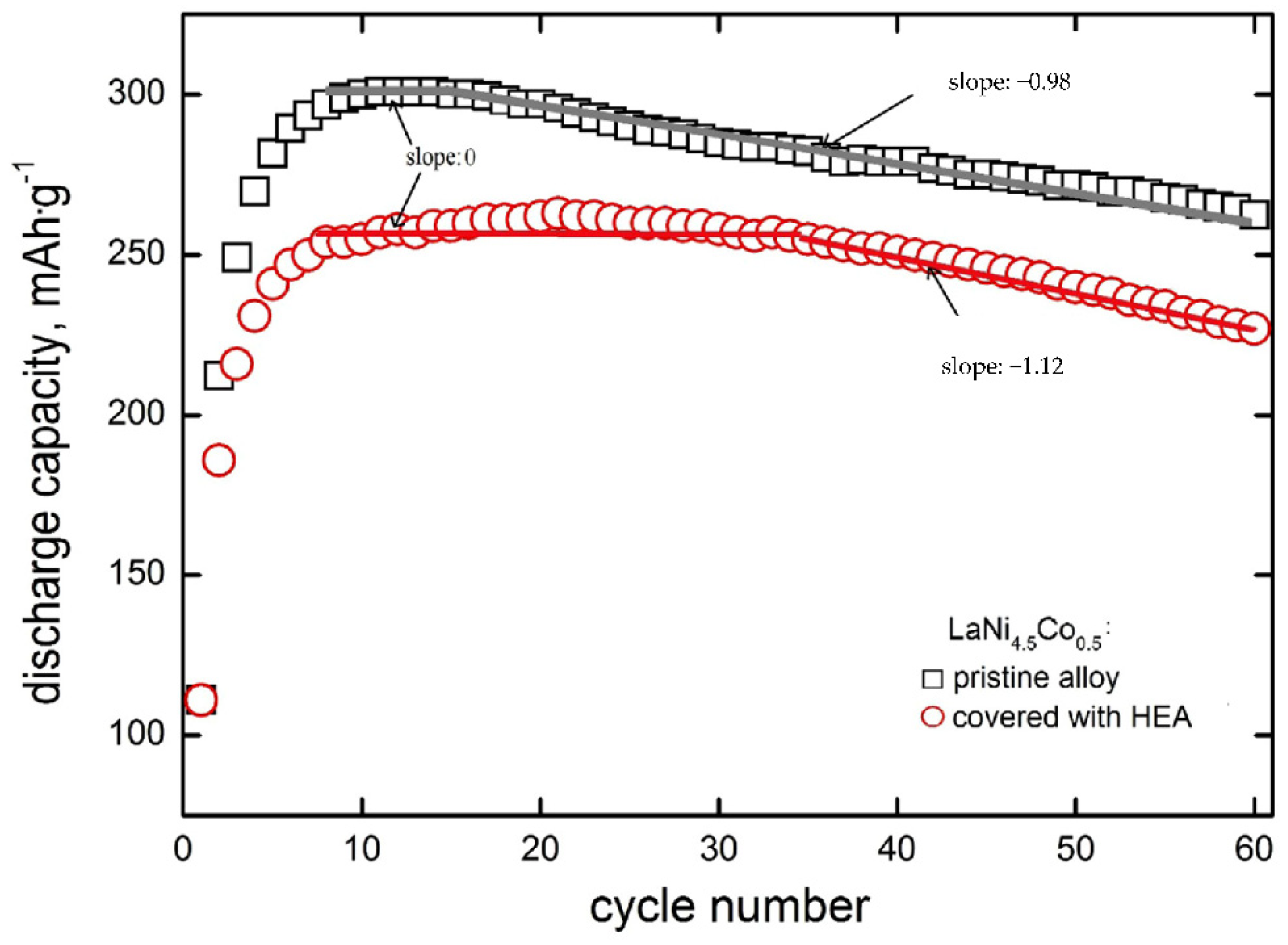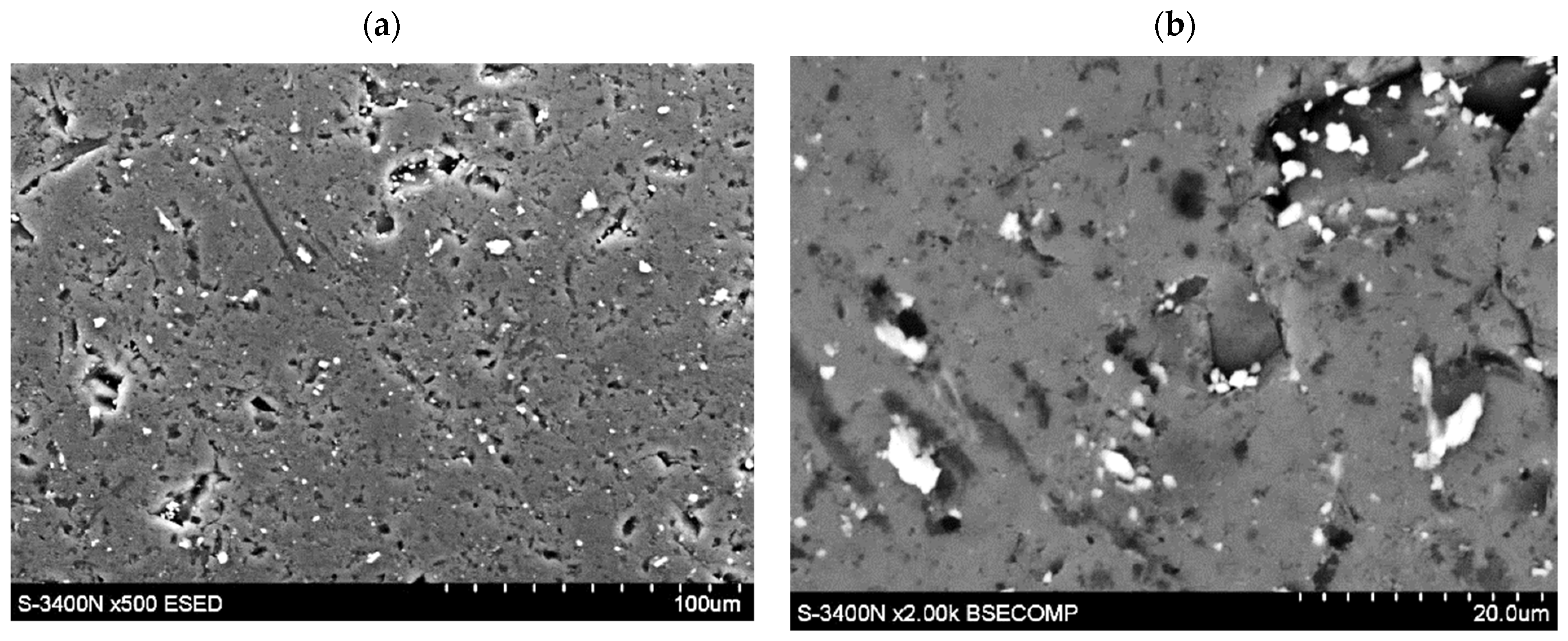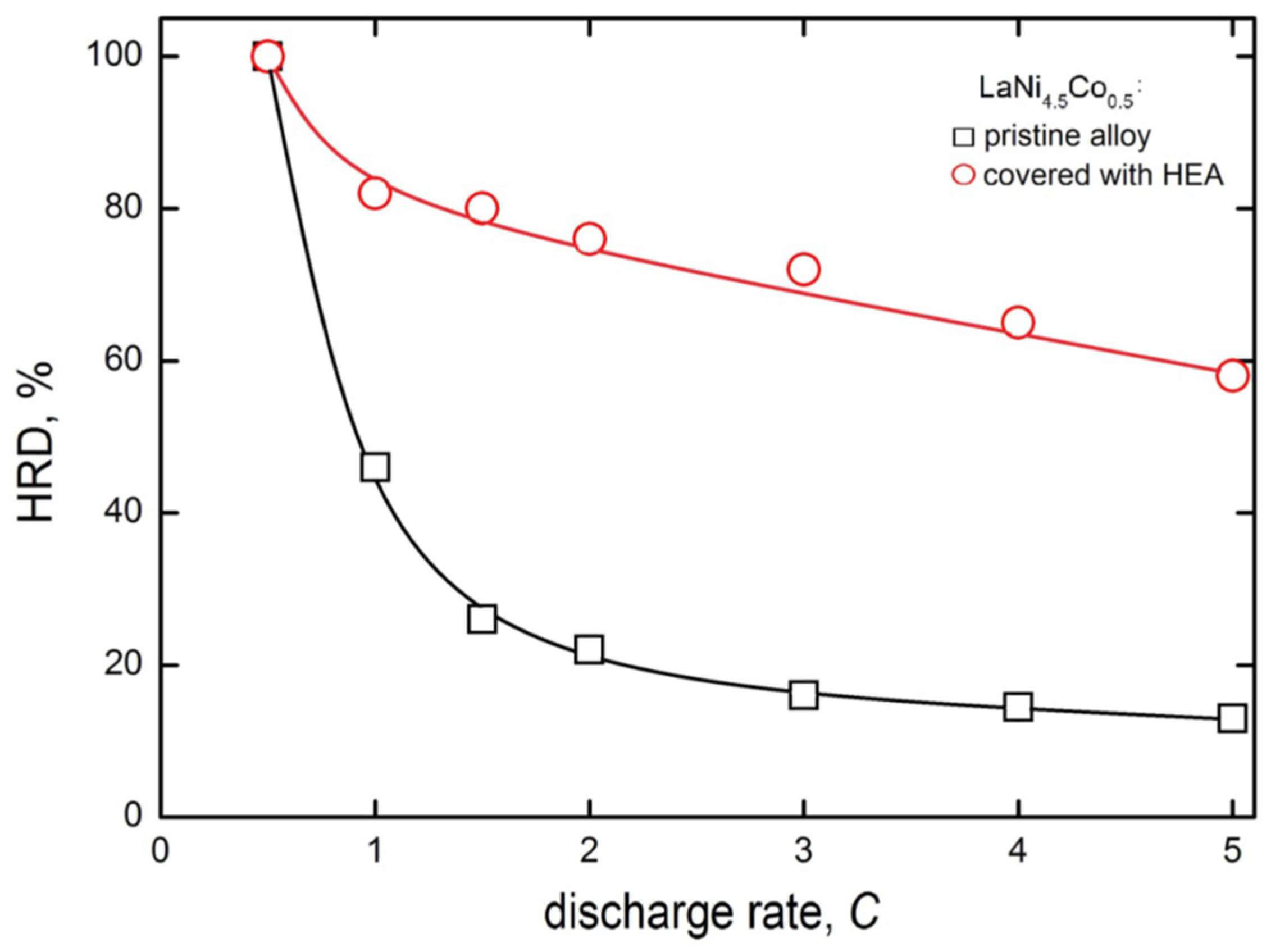Modification of Hydrogenation and Corrosion Properties of Hydrogen Storage Material by Amorphous TiCrFeCoNi HEA Layer
Abstract
:1. Introduction
2. Materials and Methods
3. Results
3.1. Evaluation of the Morphology and Chemical Composition of HEA-Modified LaNi4.5Co0.5 Powder Particles
3.2. Phase Analysis of the Tested Powder Samples
3.3. Effect of HEA Sputtering on Discharge Capacity of the Tested HSM Electrodes
3.4. Effect of HEA Modification on Exchange Current Density of H2O/H2 System
4. Conclusions
- The magnetron sputtering of high-entropy alloy with equimolar TiCrFeCoNi stoichiometry on active particles of hydrogen storage powder (LaNi4.5Co0.5) allowed to modify the particle surface with about 0.5 µm thick amorphous layers of the applied HEA;
- The analysis of the LaNi4.5Co0.5 particle morphology material coated with a TiCrFeCoNi layer of the applied HEA showed that the powders had irregular shapes, with numerous microcracks and faults, and their average diameters ranged from several hundred nm to 50 µm. The chemical composition of the coating was practically the same as the composition of the HEA target. The XRD phase analysis showed the amorphous structure of the HEA coating;
- The HEA-modified LaNi4.5Co0.5 material displays no capacity fade during the first 35 charge/discharge cycles in 6 M KOH. Longer cycling reveals galvanic effects and local corrosion attacks, most probably due to the presence of discontinuities in HEA coating that facilitate permeability of the electrolyte through the surface layers. As a result, the corrosion process of HEA-modified electrodes for longer cycling proceeds faster (by about 15%) than that of pristine material;
- HEA modification increases the exchange current density of the H2O/H2 system on the tested HSM electrode. This advantageous effect occurs up to 35 charge/discharge cycles and then disappears;
- HEA sputtering of LaNi4.5Co0.5 material particles significantly improves the high-rate dischargeability of the hydride electrodes: at a discharge rate equal to 5C, the HRD parameter is 4.6 times greater for the HEA modified material.
Author Contributions
Funding
Institutional Review Board Statement
Informed Consent Statement
Data Availability Statement
Conflicts of Interest
References
- Cantor, B.; Chang, I.T.H.; Knight, P.; Vincent, A.J.B. Microstructural development in equiatomic multicomponent alloys. Mater. Sci. Eng. A 2004, 375 (Suppl. C), 213–218. [Google Scholar] [CrossRef]
- Yeh, J.W.; Chen, S.K.; Lin, S.J.; Gan, J.Y.; Chin, T.S.; Shun, T.T.; Tsau, C.H.; Chang, S.Y. Nanostructured high-entropy alloys with multi-principal elements–novel alloy design concepts and outcomes. Adv. Eng. Mater. 2004, 6, 299–303. [Google Scholar] [CrossRef]
- Cui, G.; Han, B.; Yang, Y.; Li, M.; Li, J. Sulfurizing of CoCrFeNiSi0.4 and CoCrFeMoNi high entropy alloys fabricated by laser cladding. Surf. Coatings Technol. 2020, 381, 125182. [Google Scholar] [CrossRef]
- Cai, Y.; Zhu, L.; Cui, Y.; Geng, K.; Manladan, S.M.; Luo, Z. High-temperature oxidation behavior of FeCoCrNiAlx high-entropy alloy coatings. Mater. Res. Express 2019, 6, 11. [Google Scholar] [CrossRef]
- Khan, N.A.; Akhavan, B.; Zhou, H.; Chang, L.; Wang, Y.; Bilek, L.S.M.M.; Liu, Z. High entropy alloy thin films of AlCoCrCu0.5FeNi with controlled microstructure. Appl. Surf. Sci. 2019, 495, 143560. [Google Scholar] [CrossRef]
- Gu, Z.; Xi, S.; Sun, C. Microstructure and properties of laser cladding and CoCr(2.5)FeNi(2)Tix high-entropy alloy composite coatings. J. Alloys Compd. 2020, 819, 152986. [Google Scholar] [CrossRef]
- Yeh, J.W.; Yu-Liang, C.; Su-Jien, L.; Swe-Kai, C. High-Entropy Alloys—A New Era of Exploitation. Mater. Sci. Forum 2007, 560, 1–9. [Google Scholar] [CrossRef]
- Yeh, J.W. Recent progress in high-entropy alloys. Ann. Chim. Sci. Mater. 2006, 31, 633–648. [Google Scholar] [CrossRef]
- Wang, Y.P.; Li, B.S.; Ren, M.X.; Yang, C.; Fu, H.Z. Microstructure and compressive properties of AlCrFeCoNi high entropy alloy. Mater. Sci. Eng. 2008, 491, 154–158. [Google Scholar] [CrossRef]
- Pi, J.; Pana, Y.; Zhanga, L.; Zhang, H. Microstructure and property of AlTiCrFeNiCu high-entropy alloy. J. Alloys Compd. 2011, 509, 5641–5645. [Google Scholar] [CrossRef]
- Chen, T.K.; Shun, T.T.; Yeh, J.W.; Wong, M.S. Nanostructured nitride films of multi-element high-entropy alloys by reactive DC sputtering. Surf. Coat. Technol. 2004, 1, 193–200. [Google Scholar] [CrossRef]
- Huang, Y.S.; Chen, L.; Lui, H.W.; Cai, M.H.; Yeh, J.W. Microstructure, hardness, resistivity and thermal stability of sputtered oxide films of AlCoCrCu0.5NiFe high-entropy alloy. J. Mater. Sci. Eng. A 2007, 1–2, 77–83. [Google Scholar] [CrossRef]
- Khazaeli, H.; Falahati, D.P.J. Electrochemical investigation and modelling of LaNi4.77Al0.23 thin-films sputtered on glass wafers. J. Alloys Compd. 2019, 772, 199–208. [Google Scholar] [CrossRef]
- Paillier, J.; Roué, L. Physical and analytical electrochemistry-nanostructured palladium thin films prepared by pulsed laser deposition-structural characterizations and hydrogen electrosorption properties. J. Electrochem. Soc. 2005, 152, E1. [Google Scholar] [CrossRef]
- Okuno, K. Development of a compact electron beam ion source cooled with liquid nitrogen. Jpn. J. Appl. Phys. 1989, 28, 1124. [Google Scholar] [CrossRef]
- Mattox, D. Fundamentals of ion plating. J. Vac. Sci. Technol. 1973, 10, 47–52. [Google Scholar] [CrossRef]
- Adachi, G.-Y.; Niki, K.-I.; Shiokawa, J. The effect of hydrogen absorption on the electrical resistivity of LaNi5 film. J. Less Common Met. 1981, 81, 345–348. [Google Scholar] [CrossRef]
- Goc, K.; Prendota, W.; Przewoznik, J.; Gondek, Ł.; Kapusta, C.; Radziszewska, A.; Mineo, K.; Takasaki, A. Magnetron sputtering as a method for introducing catalytic elements to magnesium hydride. Int. J. Hydrogen Energy 2018, 43, 20836–20842. [Google Scholar] [CrossRef]
- Pavlenko, V.I.; Cherkashina, N.I.; Yastrebinsky, R.N.; Demchenko, O.V. On Enhancing the Thermal Stability of Metal Hydrides by Ion-Plasma Vacuum Magnetron Sputtering. J. Surface Investig. 2017, 11, 254–258. [Google Scholar] [CrossRef]
- Sakaguchi, H.; Taniguchi, N.; Seri, H.; Shiokawa, J.; Adachi, G. Mechanical properties of LaNi5 thin films prepared by sputtering and vapor deposition methods and determination of the hydrogen content in these films. J. Appl. Phys. 1988, 64, 888–892. [Google Scholar] [CrossRef]
- Kashkarov, E.B.; Nikitenkov, N.N.; Sutygina, A.N. Hydrogenation behavior of Ti-implanted Zr-1Nb alloy with TiN films deposited using filtered vacuum arc and magnetron sputtering. Appl. Surface Sci. 2018, 43, 207–213. [Google Scholar] [CrossRef]
- Milcius, D.; Grbovic-Novakovic, J.; Zostautiene, R.; Lelis, M.; Girdzevicius, D.; Urbonavicius, M. Combined XRD and XPS analysis of ex-situ and in-situ plasma hydrogenated magnetron sputtered Mg films. J. Alloys Compd. 2015, 647, 790–796. [Google Scholar] [CrossRef]
- Wang, Z.; Li, C.Y.V.; Zhou, H.; Liu, S.; Chan, S. Electrochemical hydrogen storage in LaNi4.25Al0.75 alloys: A comparative study between film and powder materials. Mater. Char. 2008, 59, 468–472. [Google Scholar] [CrossRef]
- Sakai, T.; Ishikawa, H.; Miyamura, H.; Kuriyama, N.; Yamada, S.; Iwasaki, T. Thin film preparation of hydrogen storage alloys and their characteristics as metal hydride electrodes. J. Electrochem. Soc. 1991, 138, 908–915. [Google Scholar] [CrossRef]
- Dymek, M.; Nowak, M.; Jurczyk, M.; Bala, H. Encapsulation of La1.5Mg0.5Ni7 nano-crystalline hydrogen storage alloy with Ni coatings and its electrochemical characterization. J. Alloys Compd. 2018, 749, 534–542. [Google Scholar] [CrossRef]
- Giemza, A.; Bala, H. High rate dischargeability of hydride electrode modified with magnetron sputtered MCrFeCoNi (M = V or Mn) coatings. Ochr. Przed Koroz. 2018, 61, 218–221. [Google Scholar] [CrossRef]
- Dymek, M.; Nowak, M.; Jurczyk, M.; Bala, H. Electrochemical characterization of nanocrystalline hydrogen storage La1.5Mg0.5Ni6.5Co0.5 alloy covered with amorphous nickel. J. Alloys Compd. 2019, 780, 697–704. [Google Scholar] [CrossRef]
- Dymek, M.; Nowak, M.; Jurczyk, M.; Bala, H. Electrochemical behaviour of a nanostructured La1.25Gd0.25Mg0.5Ni7 hydrogen storage material modified with magnetron sputtered nickel. J. Electrochem. Soc. 2019, 166, A1393–A1399. [Google Scholar] [CrossRef]
- Shreir’s Corrosion, Subsect. 2.07: Galvanic Corrosion (Red. H.P.Hack); Subsect.4.18.6: Coatings and Cathodic Protection; Elsevier: Amsterdam, The Netherlands, 2010.
- Li, Y.; Wang, C.; Dong, Z.; Wang, J.; Yang, S.; Ke, D.; Han, S. Effects of coating layers on electrochemical properties of Nd-Mg-Ni-based alloys. Int. J. Hydrogen Energy 2017, 42, 19148–19155. [Google Scholar] [CrossRef]
- Shreir’s Corrosion, Subsect. 3.05: Aqueous Corrosion of Nickel and its Alloys (Red. H.Alves and U.Heubner); Elsevier: Amsterdam, The Netherlands, 2010.
- Bala, H.; Dymek, M.; Drulis, H. Development of metal hydride material efficient surface in conditions of galvanostatic charge/discharge cycling. Mater. Chem. Phys. 2014, 148, 1008–1012. [Google Scholar] [CrossRef]
- Dora, J. Zasilacz Rezonansowy. Patent PL nr 313150; Urząd Patentowy RP: Warszawa, Poland, 1996.
- Bordolińska, K.; Stefaniak, A.; Bala, H. Effect of magnetron sputtering of active powder with Fe-Cr-Ni layers on electrochemical parameters of metal hydride electrode. Ochr. Przed Koroz. 2016, 59, 43–45. [Google Scholar] [CrossRef]
- Stefaniak, A.; Bordolińska, K.; Bala, H. Characterization of hydride electrode modified with Fe-Si layers by sputtering. Ochr. Przed Koroz. 2016, 59, 91–93. [Google Scholar] [CrossRef]
- Stefaniak, A.; Bordolińska, K.; Bala, H. Electrochemical characteristics of LaNi4.5Co0.5 alloy composite hydrogen storage material at high discharge rates. Ochr. Przed Koroz. 2018, 61, 90–92. [Google Scholar]
- Bala, H.; Dymek, M. Corrosion degradation of powder composite hydride electrodes in conditions of long-lasting cycling. Mater. Chem. Phys. 2015, 167, 265–270. [Google Scholar]
- Dymek, M.; Bala, H. Inhibition of LaNi5 electrode decay in alkaline medium by electroless encapsulation of active powder particles. J. Solid State Electrochem. 2016, 20, 2001–2007. [Google Scholar] [CrossRef] [Green Version]
- Dymek, M.; Mościcki, A.; Bala, H. Peculiarities of LaNi5-powder/PVDF bonded composite-alkaline electrolyte interaction at repeating charge/discharge cycles. Ochr. Przed Koroz. 2013, 56, 502–505. [Google Scholar]
- Hahn, T. International Tables for Crystallography; Kluwer Academic: Dordrecht, The Netherlands; Boston, MA, USA; London, UK, 1996; Volume 584. [Google Scholar]
- Bala, H.; Dymek, M. Determination of corrosion rate of porous, liquid permeable materials on the example of hydride powder composite. Ochr. Przed Koroz. 2017, 60, 79–83. [Google Scholar] [CrossRef]
- Dymek, M.; Nowak, M.; Jurczyk, M.; Bala, H. Hydrogenation and corrosion properties of nanocrystalline A2B7 type, La-Mg-Ni based intermetallics modified by nickel sputtering. Ochr. Przed Koroz. 2020, 63, 67–71. [Google Scholar]
- Bala, H.; Kukula, I.; Giza, K.; Marciniak, B.; Rozycka-Sokolowska, E.; Drulis, H. Evaluation of the electrochemical hydrogenation and corrosion behaviour of LaNi5-based materials using galvanostatic charge/discharge measurements. Int. J. Hydrogen Energy 2012, 37, 16817–16822. [Google Scholar] [CrossRef]
- Li, M.M.; Yang, C.C.; Chen, L.X.; Jiang, Q. Hydrogen storage alloys/reduced graphite oxide: An efficient hybrid electrode with enhanced high-rate dischargeability. Electrochim. Acta 2016, 200, 59–65. [Google Scholar] [CrossRef]
- Chen, L.X.; Zhu, Y.F.; Yang, C.C.; Chen, Z.W.; Zhang, D.M.; Jiang, Q. A new strategy to improve the high-rate performance of hydrogen storage alloys with MoS2 nanosheets. J. Power Sources 2016, 333, 17–23. [Google Scholar] [CrossRef]
- Huang, J.L.; Wang, H.; Ouyang, L.Z.; Liu, J.W.; Zhu, M. Reducing the electrochemical capacity decay of milled Mg-Ni alloys: The role of stabilizing amorphous phase by Ti-substitution. J. Power Sources 2019, 438, 226984. [Google Scholar] [CrossRef]







| Element (wt.%) | La | Ni | Co | Fe | Cr | Ti |
|---|---|---|---|---|---|---|
| Deposited layer (point 1) | − | 26.2 | 20.1 | 18.6 | 18.0 | 16.5 |
| Particle interior (area 2) | 13.1 | 78.2 | 8.2 | − | − | − |
Publisher’s Note: MDPI stays neutral with regard to jurisdictional claims in published maps and institutional affiliations. |
© 2022 by the authors. Licensee MDPI, Basel, Switzerland. This article is an open access article distributed under the terms and conditions of the Creative Commons Attribution (CC BY) license (https://creativecommons.org/licenses/by/4.0/).
Share and Cite
Giemza, A.; Sozańska, M.; Bala, H. Modification of Hydrogenation and Corrosion Properties of Hydrogen Storage Material by Amorphous TiCrFeCoNi HEA Layer. Materials 2022, 15, 2593. https://doi.org/10.3390/ma15072593
Giemza A, Sozańska M, Bala H. Modification of Hydrogenation and Corrosion Properties of Hydrogen Storage Material by Amorphous TiCrFeCoNi HEA Layer. Materials. 2022; 15(7):2593. https://doi.org/10.3390/ma15072593
Chicago/Turabian StyleGiemza, Agnieszka, Maria Sozańska, and Henryk Bala. 2022. "Modification of Hydrogenation and Corrosion Properties of Hydrogen Storage Material by Amorphous TiCrFeCoNi HEA Layer" Materials 15, no. 7: 2593. https://doi.org/10.3390/ma15072593






